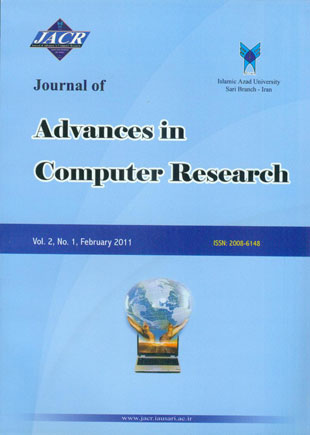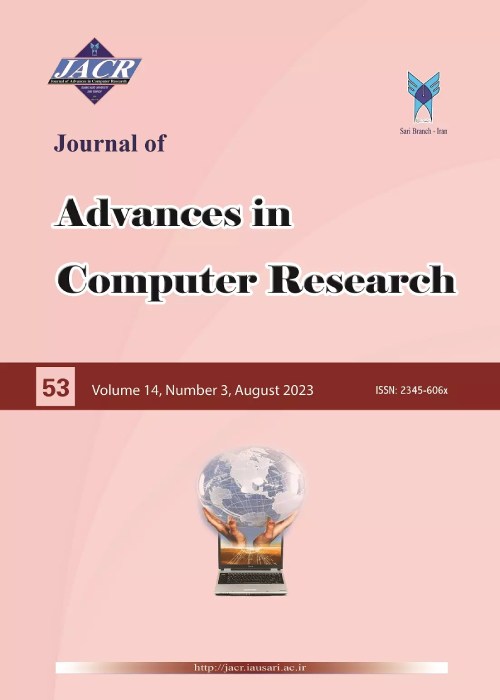فهرست مطالب

Journal of Advances in Computer Research
Volume:2 Issue: 1, Winter 2011
- 92 صفحه،
- تاریخ انتشار: 1390/07/20
- تعداد عناوین: 8
-
Pages 1-12In this paper, the gain in LD-CELP speech coding algorithm is predicted using three neural models, that are equipped by genetic and particle swarm optimization (PSO) algorithms to optimize the structure and parameters of neural networks. Elman, multi-layer perceptron (MLP) and fuzzy ARTMAP are the candidate neural models. The optimized number of nodes in the first and second hidden layers of Elman and MLP and also the initial weights and biases of these nets are determined by genetic algorithm (GA) and PSO. In the fuzzy ARTMAP, the choice parameter, α, learning rate, β, and vigilance parameter, ρ, are selected byGA and PSO, as well. In this way, the performance of GA and PSO are compared when using different neural architectures in this application. Empirical results show that when gain is predicted by Elman and MLP neural networks with GA/PSOoptimized parameters, the segmental signal to noise ratio (SNRseg) and meanopinion score (MOS) are improved as compared to traditional implementation based on ITU-T G.728 recommendation. On the other hand, fuzzy ARTMAP-based gain predictor reduces the computational complexity noticeably, with no significant degradations in SNRseg and MOS.
-
Pages 13-26Adequate coverage is one of the main problems for distributed wireless sensornetworks and The effectiveness of that highly depends on the sensor deploymentscheme. Given a finite number of sensors, optimizing the sensor deployment willprovide sufficient sensor coverage and save power of sensors for movement to targetlocation to adequate coverage. In this paper, we apply fuzzy logic system to optimizethe sensor placement after an initial random deployment. Based on Voronoidiagrams and Fuzzy logic, we design two distributed algorithms for controlling themovement of sensors. Simulation results show that our approaches maximiz thesensor coverage.
-
Pages 27-38The speech enhancement techniques are often employed to improve the qualityand intelligibility of the noisy speech signals. This paper discusses a novel techniquefor speech enhancement which is based on Singular Value Decomposition. Thisimplementation utilizes a Genetic Algorithm based optimization method for reducingthe effects of environmental noises from the singular vectors as well as the singularvalues of a noise-corrupted speech. The presented article also reviews the existingalgorithms for subspace division and carries out extensive sets of experiments toclearly show the efficiency of the proposed method in comparison with the othersuperior speech enhancement approaches.
-
Pages 39-48The type of the applications for which Internet is being used has changed overthe years. Multimedia applications, Real-time applications and Game playingrequire Quality of service. IEEE has proposed IEEE 802.11e, a quality of serviceextension to the wireless LAN standard IEEE 802.11. In this paper servicedifferentiation ability of 802.11e is evaluated. Identical traffic is considered for allAccess categories to quantitatively differentiate different Access categories. Theresults indicate, 802.11e achieves service differentiation with some limitations. NS-2.26 is used for simulation.
-
Pages 49-58Today power consumption is considered to be one of the important issues.Therefore, its reduction plays a considerable role in developing systems. Previousstudies have shown that approximately 50% of total power consumption is used incache memories. There is a direct relationship between power consumption andreplacement quantity made in cache. The less the number of replacements is, theless the power consumption is. In this paper, a mechanism was proposed amechanism to reduce power consumption using full associative organization andlayered replacement algorithm. In this scheme, all cache blocks were divided intothree layers. Final layer used FIFO replacement algorithm and middle layer usedrandom replacement algorithm. Also first layer used LRU replacement algorithm.Simulation results were shown using tools written by VB language that in theproposed plan the number of replacement was less than 8-way associative usingLRU replacement algorithm.
-
Pages 59-70Clustering is the process of dividing a set of input data into a number ofsubgroups. The members of each subgroup are similar to each other but differentfrom members of other subgroups. The genetic algorithm has enjoyed manyapplications in clustering data. One of these applications is the clustering of images.The problem with the earlier methods used in clustering images was in selectinginitial clusters. In this article it has been tried to develop a set of populations (i.e.,cluster centers) using the clonal selection of artificial immune system, and to obtainthe final clustering of clusters and the main image among a large number of clustersthrough the use the K-means and the K- nearest neighbor algorithms. Moreover,chaotic model has also been used to create diversity both in the original populationand in the populations produced through the repetition of generations. Thealgorithms in the paper have been executed on satellite images; and theimplementation results showed that the algorithm works well.
-
Pages 71-83One of the main challenges in wireless sensor network is energy problem andlife cycle of nodes in networks. Several methods can be used for increasing lifecycle of nodes. One of these methods is load balancing in nodes while transmittingdata from source to destination. Directed diffusion algorithm is one of declaredmethods in wireless sensor networks which is data-oriented algorithm. Directeddiffusion deals with two fundamental problems. First, in the network the datapackets traverse the invalid routes up to the central node in order to make newroutes and eliminate the previous ones at a very short period of time. They aredispatched from a platform lacking any central node which itself causes thedecrease of data delivery rates. Second, the reconstruction of such routes urges theapplication of exploration phase which comes along with the distribution of interestpackets and exploratory data resulting into a great deal of outputs injected into thenetwork. But with every motion, the application of exploratory phase of central nodemakes an overflow of outputs. Certainly with intense movement it enjoys highimportance. Having more than one sink, network is separated to some regions andthe proposed algorithm called Region Directed Diffusion Learning Automata(RDDLA) updates the rout between these sinks and finds interface node withlearning automata and sends packet from source to this node and transmits data tosinks with this node. This approach decreased overall network metrics up to 22%.
-
Pages 85-91The increasing reliance on information gathered from the web and otherinternet technologies raise the issue of trust. Through the development of semanticWeb, One major difficulty is that, by its very nature, the semantic web is a large,uncensored system to which anyone may contribute. This raises the question of howmuch credence to give each resource. Each user knows the trustworthiness of eachresource. Top-down or global credibility values would not be assigned due to thesubjective nature of trust. Trust policies and trust evaluation mechanisms areneeded to filter untrustworthy resource. This problem was tackled in this researchby employing a trust model for evaluating trustworthiness of each resource. Thisproposed model used semantic web metadata, recommendation, and reputation asbased factor for evaluation algorithm. The weighting and combination methods aretwo main challenges for proposed trust evaluation algorithm. These factors havevarious type and semantic. Therefore analytical hierarchy procedure (AHP)technique was applied for trust evaluation that offers justification for trust decisionsand controlled trust measurement.


